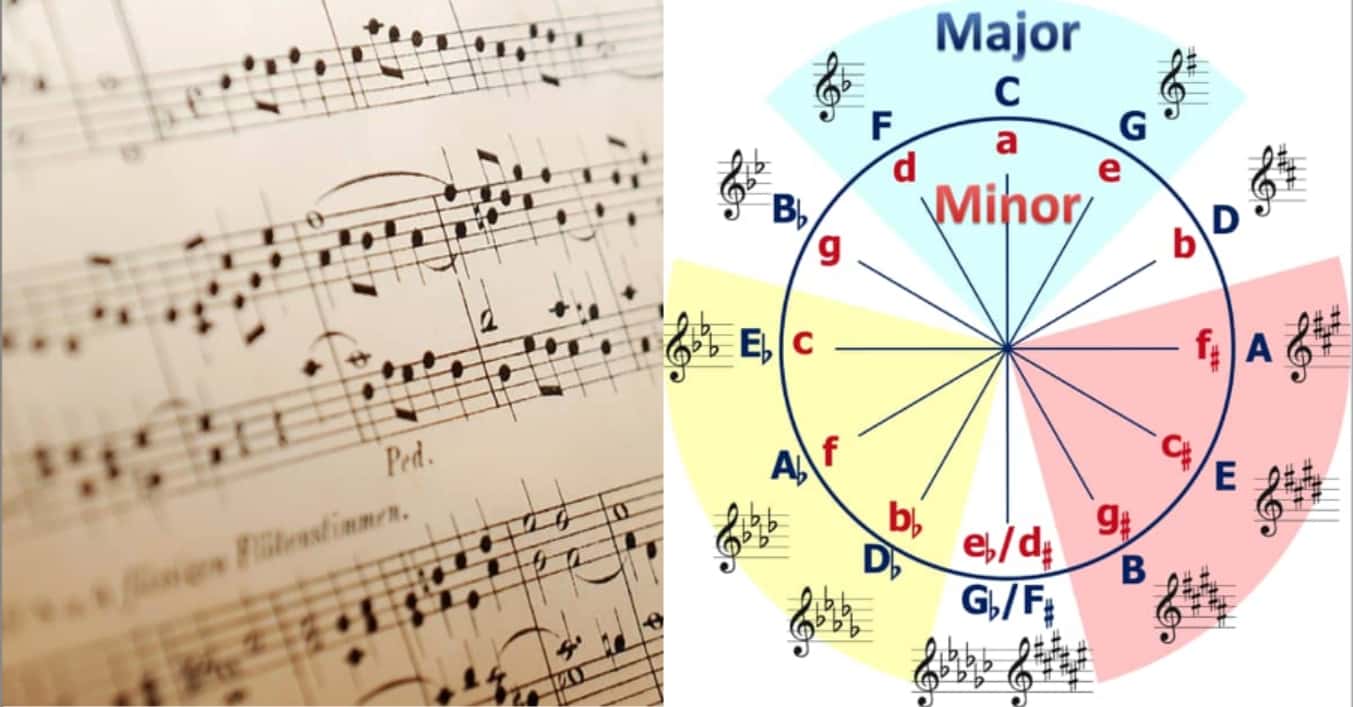Music theory is the study of the principles and elements of music. It includes the notation, structure, and style of music, as well as the principles of melody, harmony, and rhythm. An introduction to music theory is presented here, along with many Music Theory Learning Documents further below.
Basic elements in music theory:
- Pitch is the highness or lowness of a musical sound, which is determined by the frequency of the sound waves.
- Scales are a series of pitches arranged in ascending or descending order. The most common scale in Western music is the major scale, which consists of eight notes and has a specific pattern of whole and half steps.
- Intervals are the separation between two pitches. With the exception of half steps, which are denoted by the symbols “m” (minor) and “M,” the size of the interval is determined by the number of letter names that separate the two pitches (major).
- Chords are two or more pitches played simultaneously. The most common chords in Western music are triads, which are three-note chords made up of a root, third, and fifth.
- Harmony is the combination of two or more pitches played simultaneously to create a pleasing sound. In tonal music, harmony is created by the use of chords that are based on a tonic (central) pitch and its associated scale.
- Melody is a sequence of individual pitches played one after the other. Melody is often the most prominent element in a piece of music and is used to convey emotion and structure.
There are many other concepts in music theory, including meter, rhythm, form, and timbre. These concepts can be studied in more depth through music theory courses or by reading music theory texts.
Pitch in music
Pitch is the highness or lowness of a musical sound, which is determined by the frequency of the sound waves. In Western music, pitches are typically notated using the alphabetical letters A through G. Pitches can also be modified by the use of accidentals, which are symbols that alter the pitch of a note by a half step. For example, a sharp symbol (#) raises the pitch of a note by a half step, while a flat symbol (b) lowers the pitch of a note by a half step.
Pitch is an important aspect of music because it contributes to the creation of melody and harmony. The relationships between pitches in tonal music, which is based on a central pitch called the tonic, create a sense of tonality, or the feeling of being in a specific key. An interval is the distance between two pitches, and the size of an interval is determined by the number of letter names between the two pitches.
Pitch can also be affected by the timbre of an instrument or voice. Timbre is the quality of a sound that distinguishes it from other sounds, and it is determined by the harmonic content of a sound wave. Different instruments and voices have unique timbres that can affect the perceived pitch of a sound.
In summary, pitch is an important element in music that is determined by the frequency of sound waves and can be modified by the use of accidentals. It helps to create melody and harmony, and is also affected by the timbre of an instrument or voice.
Scales in music
A scale is a series of pitches arranged in ascending or descending order. Scales are an important element in music because they provide a framework for melodies and harmonies. In Western music, the most common scale is the major scale, which consists of eight notes and has a specific pattern of whole and half steps.
The major scale is built on a specific pattern of whole and half steps:
- Whole step: Two pitches that are separated by a distance of two half steps (eg C to D)
- Half step: The smallest interval in Western music, equal to half a whole step (eg C to C#)
The whole and half step pattern for the major scale is:
Whole, Whole, Half, Whole, Whole, Whole, Half
For example, the C major scale consists of the pitches C, D, E, F, G, A, B, C. The distance between each of these pitches is determined by a pattern of whole and half steps.
There are many other types of scales in Western music, including minor, pentatonic, and chromatic scales. Each type of scale has its own unique pattern of intervals and is used in different musical styles and contexts.
In short, a scale is a series of pitches arranged in ascending or descending order. The most common scale in Western music, the major scale, is constructed using a particular pattern of whole and half steps. Numerous more scale types are employed in various musical genres and settings.
Intervals in music
The term “interval” refers to the distance between two musical pitches. The magnitude of an interval is defined by counting the number of pitch names between the two notes, excluding half steps, which are represented by “m” for minor or “M” for major.
There are several types of intervals in music:
- Unisons: When two pitches are the same, the interval is called a unison. For example, C to C is a unison.
- Seconds: When two pitches are one half step apart, the interval is called a second. There are two types of seconds: minor seconds (m2) and major seconds (M2). For example, C to D is a major second, while C to Db is a minor second.
- Thirds: When two pitches are two half steps apart, the interval is called a third. There are two types of thirds: minor thirds (m3) and major thirds (M3). For example, C to E is a major third, while C to Eb is a minor third.
- Fourths: When two pitches are three half steps apart, the interval is called a fourth. There are two types of fourths: perfect fourths (P4) and augmented fourths (A4). For example, C to F is a perfect fourth, while C to F# is an augmented fourth.
- Fifths: When two pitches are four half steps apart, the interval is called a fifth. There are two types of fifths: perfect fifths (P5) and diminished fifths (d5). For example, C to G is a perfect fifth, while C to Gb is a diminished fifth.
There are many other types of intervals, including sixths, sevenths, octaves, and compound intervals (intervals larger than an octave). Intervals can be classified as consonant or dissonant based on their perceived pleasantness or unpleasantness. Consonant intervals are generally considered more pleasant and stable, while dissonant intervals are generally considered more tense and unstable.
In summary, intervals are the distances between two pitches. The size of an interval is determined by the number of letter names between the two pitches, and there are many different types of intervals with specific names and characteristics. Intervals can be consonant or dissonant based on their perceived pleasantness or unpleasantness.
Chords in music
When two or more pitches are played simultaneously, they combine to form a chord. Because they offer harmony and can imply movement and direction, chords are a crucial component of music.
The most common chords in Western music are triads, which are three-note chords made up of a root, third, and fifth. The root is the pitch that the chord is named after, and the third and fifth are intervals above the root.
There are four types of triads:
- Major triads: A major triad consists of a root, a major third, and a perfect fifth. For example, the C major triad consists of the pitches C, E, and G.
- Minor triads: A minor triad consists of a root, a minor third, and a perfect fifth. For example, the C minor triad consists of the pitches C, Eb, and G.
- Augmented triads: An augmented triad consists of a root, a major third, and an augmented fifth. For example, the C augmented triad consists of the pitches C, E, and G#.
- Diminished triads: A diminished triad consists of a root, a minor third, and a diminished fifth. For example, the C diminished triad consists of the pitches C, Eb, and Gb.
Chords can also be expanded by adding additional pitches above the root, third, and fifth. These augmented chords, such as seventh and ninth chords, can add more complexity and color to the chord progression.
In summary, a chord is a combination of two or more pitches played simultaneously. Triads are the most common chords in Western music and are made up of a root, third, and fifth. Chords can also be extended by adding additional pitches above the root, third, and fifth.
Harmony in music
Harmony is the simultaneous playing of two or more pitches to produce a pleasant sound. Harmony is established in tonal music, which is centered on a core pitch called the tonic, by employing chords based on the tonic and its accompanying scale.
There are several principles that govern harmony in tonal music:
- Consonance and dissonance: Consonant chords are generally considered more pleasant and stable, while dissonant chords are generally considered more tense and unstable. The degree of consonance or dissonance is determined by the intervals between the pitches in the chord.
- Tension and resolution: Harmony may produce tension and resolution by employing discordant chords to create tension and consonant chords to resolve that tension. This may give a piece of music a sense of movement and direction.
- Functional harmony: In tonal music, certain chords are typically used in specific ways to create a sense of tonality, or a feeling of being in a particular key. These chords are known as functional chords, and they include the tonic, dominant, and subdominant chords. The tonic chord provides a sense of stability and resolution, the dominant chord creates tension and a sense of motion, and the subdominant chord provides a sense of relaxation and movement away from the tonic.
Harmony can also be created using non-tonal techniques, such as atonality, in which chords and melodies do not conform to a tonal center, and polytonality, in which multiple tonal centers coexist within a single piece of music.
In summary, harmony is the combination of two or more pitches played simultaneously to create a pleasing sound. In tonal music, harmony is created using functional chords and the principles of consonance and dissonance, tension and resolution. Harmony can also be created using non-tonal techniques such as atonality and polytonality.
Melody in music
A melody is made up of a series of distinct pitches played one after another. The melody, which is utilized to express emotion and give a piece of music structure, is frequently the most noticeable component.
The following are elements of melody that are important in music:
- Pitch: The highness or lowness of a musical sound is determined by the frequency of the sound waves, and is an important element in melody.
- Rhythm: The way that pitches are arranged in time is known as rhythm, and is an important element in melody. Rhythm can be simple or complex, and can be affected by factors such as tempo, meter, and phrasing.
- Contour: The overall shape of a melody is known as contour, and can be described as rising, falling, or remaining the same. The contour of a melody can have a significant impact on its emotional expression.
- Range: A melody’s range is the distance between its highest and lowest tones. A melody with a broad range is more dramatic and expressive, whereas a melody with a small range is more delicate and intimate.
Melodies may be composed utilizing a number of approaches, including scales, intervals, and phrasing. Melodies in tonal music are frequently based on the tonic and its accompanying scale, and may employ methods such as repetition and variation to provide structure.
In summary, a melody is a sequence of successively played single pitches that convey emotion and structure. Methods like scales, intervals, and phrasing are used to compose a melody. It is composed of elements like pitch, rhythm, contour, and range.
Meter and Rhythm in music
Meter is the organization of musical time into regular, recurring patterns of strong and weak beats. In Western music, meter is indicated by the use of time signatures, which consist of two numbers placed at the beginning of a piece of music. The top number indicates the number of beats in a measure, and the bottom number indicates the type of note that receives one beat.
For example, a 4/4 time signature indicates that the bar has four beats and that the quarter note receives one beat. Time 3/4 indicates that the bar has three beats and that the quarter note receives one beat.
Rhythm is the way pitches and rhythms are arranged in time. Rhythm can be simple or complex and can be affected by factors such as meter, tempo and phrasing.
In Western music, rhythms are typically notated using a combination of notes and rests. Notes represent pitches that are played for a certain duration, while rests represent silence. The duration of a note is determined by its shape and position on the staff. For example, a whole note is held for four beats, while a quarter note is held for one beat.
In summary, meter is the organization of musical time into regular, recurring patterns of strong and weak beats, and is indicated by the use of time signatures. Rhythm is the way that pitches and rhythms are arranged in time, and is notated using notes and rests. Rhythm can be simple or complex and can be affected by factors such as meter, tempo, and phrasing.
Music Theory Learning Documents
(all in pdf format)
- Building Your Percussion Vocabulary
- Classical Sheet Music
- Elementary Music Curriculum Grades 1-6
- Elementary Music Education Manual Grades K-5
- Fundamentals of Piano Practice
- Games for the Elementary Music Classroom
- Got Rhythm Cue Sheet
- Guitar Wikibook
- Guitar Writing Songs Wikibook
- Identify Time Signatures – 1
- Identify Time Signatures – 2
- Music Theory Blues Wikibook
- Music Theory Chords and Chord Patterns Wikibook
- Music Theory Consonance and Dissonance Wikibook
- Music Theory for Musicians and Normal People
- Music Theory Fundamentals Wikibook – Notation
- Music Theory Fundamentals Wikibook – Pitch
- Music Theory How to Read Music Wikibook
- Music Theory Modes Wikibook
- Music Theory Rhythm Wikibook
- Music Theory Scales and Intervals Wikibook
- Music Theory Cheat Poster
- Musical Instruments – Worksheets
- Musical Instruments – Worksheets Answers
- Notation Cheat Sheet – For large-sized paper
- Notation Cheat Sheet – Quadrants tape together
- Note Names – Worksheets
- Note Names – Worksheet Answers
- The Elements of Music
- What is Jazz Cue Sheet
- Writing Effective Songs Wikibook
Free Music Theory Course:
(All files are in pdf format. Some reference links are broken, you can use archive.org to access them.)
- Music Theory Course Introduction
- Music Theory Lesson 1 – Staffs, Clefs & Pitch Notation
Music Theory Lesson 2 – Notes & Rests - Music Theory Lesson 3 – Measures and Bars
Music Theory Lesson 4 – Time Signatures and Meter - Music Theory Lesson 5 – Tempo
- Music Theory Lesson 6 – The Keyboard
- Music Theory Lesson 7 – Small Intervals
- Music Theory Lesson 8 – Major Scales
- Music Theory Lesson 9 – Key Signatures and Accidentals
- Music Theory Lesson 10 – Minor Scales
- Music Theory Lesson 11 – Chromatic Scales
- Music Theory Lesson 12 – Intervals
- Music Theory Lesson 13 – Inversion of Intervals
- Music Theory Lesson 14 – Other Clefs
- Music Theory Lesson 15 – Note Groupings
- Music Theory Lesson 16 – Triads and Chords
- Music Theory Lesson 17 – Chords in Detail
- Music Theory Lesson 18 – Figured Bass
- Music Theory Lesson 19 – Transposition
- Music Theory Lesson 20 – Rhythmic Variety
- Music Theory Lesson 21 – Phrasing and Articulation
- Music Theory Lesson 22 – Chords and Cadences
- Music Theory Lesson 23 – Ornamentation
- Music Theory Lesson 24 – Repeats
- Music Theory Lesson 25 – Notes, Harmonies and Scales
- Music Theory Lesson 26 – Score Formats
- Music Theory Lesson 27 – Pitch, Temperament and Timbre
- Music Theory Lesson 28 – Musical Instrument Fingering Charts
- Music Theory Lesson 29 – Musical Instrument Ranges and Names
- Music Theory Lesson 30 – Guitar Tablature and Notation
- Music Theory Lesson 31 – Key Centres
- Music Theory Lesson 32 – Words and Music
- Music Theory Lesson 33 – Counterpoint
- Music Theory Lesson 34 – Drums and Drumming
- Music Theory Lesson 35 – Music before the 16th Century
- Music Theory Lesson 36 – Music of the 16th Century
- Music Theory Lesson 37 – Music of the 17th Century
- Music Theory Lesson 38 – Music of the 18th Century
- Music Theory Lesson 39 – Music of the 19th Century
- Music Theory Lesson 40 – Music of the 20th Century
- Music Theory Lesson 41 – A Practical Guide to Composition
- Music Theory Lesson 42 – Artistic Orchestration (see this content on archive.org)
- Music Theory Lesson 43 – Ear Tests and Drills (Practicespot website is accessible here)
- Music Theory Lesson 44 – Jazz Improvisation Almanac
More music and music theory educational materials are freely available on our Music page.
-love learning -your best ed lessons guide, Scott




